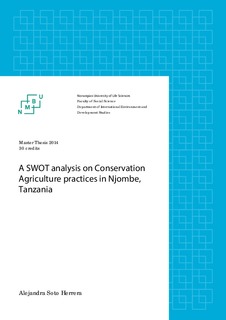A SWOT analysis on Conservation Agriculture in Njombe, Tanzania
Master thesis
Permanent lenke
http://hdl.handle.net/11250/277549Utgivelsesdato
2015-02-24Metadata
Vis full innførselSamlinger
Sammendrag
This paper presents an assessment of Conservation agriculture (CA) practices in Njombe, Tanzania by using SWOT method as the analyzing tool. It outlines the main Strengths, Weaknesses, Opportunities and Threats farmers face when implementing CA practices in their villages. The four villages selected were in CA introductory phase. The main objective of the study was to investigate whether or not CA practices can be implemented and how farmers could best adopt these practices. To collect the necessary data mixed methods were used. Ninety-two interviews were made with individual households in order to discover their perceptions and their attitudes towards CA. After gathering the data, they were analyzed in two sections: Section 1 includes an initial SWOT analysis of farmers’ current agricultural practices. Section 2 includes a second SWOT analysis based on the CA methods practiced in these villages. Results obtained from this analysis reveal that the main strengths are the current knowledge about soil conservation and the participation in livestock and agricultural groups. The main weaknesses, which farmers need to address is the lack of storage facilities. A constraint to adoption is also the limited follow-up from extension officers and village leaders after providing training and carrying out demonstration projects. New markets and more sources of income are important opportunities for farmers. Price fluctuation and climate change are being seeing as threats. Additional practices such as agroforestry and the use of bio slurry as organic fertilizer should be assessed and promoted among farmers. These practices are considered beneficial in addition to what CA practices bring. Farmers already have the necessary knowledge, to continue using current practices and adopt new methods when needed. Feedback and efficient communication is a key factor for farmers to achieve their main goals, which are improving living standards and food security.
